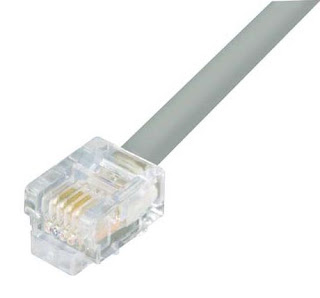Old Networking Tech - HomePNA, HomePlug, and Other Oddities
 |
| An RJ11 Cable |
While I can’t even imagine using 1Mbps for anything these days, in 2001 many were still using dial-up Internet, and DSL (e.g. SBC) or cable modem speeds (e.g., AT&T @Home) were anywhere from 384 kilobits/second (!) to ~7.5 Mbps down, 128–384 Kbps up (seriously!). So a 1 Mbps internal connection wasn’t that much of a bottleneck.
Within the year, ComputerGeeks had a HomeFree Home Networking Kit - 10Mbps!!! kit for $5 more. 10 megabit was about where many home networks probably sat at the time, 10 Mbps network interface cards and hubs / switches had become incredibly cheap. 100 Megabit was already around, though, and gigabit would soon become standard equipment in most machines and the switches etc. to support it were coming down in price to the point where it made sense to deploy at home.
 |
| ROLM dataphone |
Another weird tech product I’d never even heard of before today was the Bluetooth Wireless Networking Dongle, which apparently, in pairs, allowed two computers to communicate wirelessly over Bluetooth, at 723Kbps (max). Can’t imagine why that never caught on.
On the subject of campus wireless tech that died on the vine; does anyone remember Ricochet? Or the Palm VII, or the OmniSky Minstrel V sled that popped onto the back of a Palm Vx?
Really the wild west. Crazy days.
WiFi really started to become “a thing” around 2002. (SKUs started to trickle down to shops like ComputerGeeks until early 2003), and the tech was initially limited to the 11 Mbps of 802.11b. I picked up my first PCMCIA 802.11b card, a Milan ShAir Office, at DEFCON X in 2002 to use with my magnesium-frame Sony VAIO PCG-Z505R (running Linux, natch; gods that thing was sexy, at least for the era before the MacBook Air - the silver PowerBooks came close, but with the optical drive were kind of chunky), and then equipped my home with a chonky BEFW11S4 shortly afterwards, a 4-port 10/100 switch with an 802.11b 10Mbps WiFi radio that sold for $149 but was frequently on sale for around $100. Starbucks started offering WiFi in 2002, and by 2010 Starbucks WiFi was free.
Speaking of WiFi, circa 2009 or so, fighting frequency saturation with many neighbors’ wireless networks all contending for the same slice of spectrum, I deployed another relatively dead-end home networking technology, HomePlug, to bring network access (especially streaming video) to my living room home theater stack (this was back when Netflix was still a Wii app you loaded from an optical disk!)
I think I paid $80 at Fry’s [RIP] for
(theoretically) 200Mbs hardware (the Netgear XAVB1004 kit)
that actually gave me about 70 Mbps over 1970s wiring. Not too shabby.
Allowed me to use an Apple TV 2 (and Wii (with adapter), and XBox 360) to stream video on
my living room home theater, without hiccups. Over WiFi, the Apple TV
was unusable. That setup persisted until I changed out my carpet and ran
flat Ethernet (and speaker) wire underneath, bringing gigabit to that
stack. The HomePlug stuff is still out there and viable, now pushing (theoretical) gigabit speeds. I can think of a few applications where they make sense (e.g., as a WiFi extender, to setup a remote WiFi access point, or for outbuildings or stubborn corners of a house where WiFi isn’t reliable and dropping in a CAT6 cable is more hassle than it’s worth).
Comments
Post a Comment